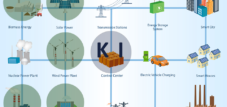Published on: July 22, 2025 / update from: July 22, 2025 – Author: Konrad Wolfenstein

The great mistake: why AI does not necessarily have to be the enemy of data protection – picture: xpert.digital
The great reconciliation: how new laws and clever technology bring AI and data protection together
Yes, AI and data protection can work – but only under these decisive conditions
Artificial intelligence is the driving force of the digital transformation, but your insatiable hunger for data raises a fundamental question: Do groundbreaking AI tools fit together and the protection of our privacy at all? At first glance, it seems to be an unsolvable contradiction. On the one hand, there is a desire for innovation, efficiency and intelligent systems. On the other hand, the strict rules of the GDPR and the right of each individual are on informational self -determination.
For a long time the answer seemed clear: more AI means less data protection. But this equation is increasingly questioned. In addition to the GDPR, the new EU AI ACT creates a second strong regulatory framework, which is specially tailored to the risks of AI. At the same time, technical innovations such as Federated Learning or Differential Privacy enable to train AI models for the first time without revealing sensitive raw data.
So the question is no longer whether AI and data protection match, but how. For companies and developers, it becomes a central challenge to find balance – not only to avoid high fines, but to create trust that is essential for a broad acceptance of AI. This article shows how the apparent opposites can be reconciled by a clever interaction of law, technology and organization and how the vision of a data protection -compliant AI becomes reality.
This means a double challenge for companies. Not only threatens sensitive fines of up to 7 % of the global annual turnover, but also the trust of customers and partners is at stake. At the same time, an enormous opportunity opens up: if you know the rules of the game and think about data protection right from the start (“Privacy by Design”), you can not only act legitimate, but also secure a decisive competitive advantage. This comprehensive guide explains how the interplay of GDPR and AI Act works, which specific dangers lurk in practice and with what technical and organizational measures you master the balance between innovation and privacy.
Suitable for:
What does data protection mean in the age of AI?
The term data protection describes the legal and technical protection of personal data. In the context of AI systems, he becomes a double challenge: Not only do the classic principles such as legality, purpose binding, data minimization and transparency remain, at the same time complicit the often complex, learning models to understand the data flows. The area of tension between innovation and regulation gains sharpness.
Which European legal bases regulate AI applications?
The focus is on two regulations: the General Data Protection Regulation (GDPR) and the EU Ordinance on Artificial Intelligence (AI Act). Both apply in parallel, but overlap in important points.
What are the core principles of the GDPR in connection with AI?
The GDPR obliges every person responsible to process personal data only on a clearly defined legal basis, to determine the purpose in advance, to limit the amount of data and to provide comprehensive information. In addition, there is a strict right to information, correction, deletion and objection to automated decisions (Art. 22 GDPR). The latter in particular takes effect directly with AI-based score or profiling systems.
What does the AI Act also bring into play?
The AI Act divides AI systems into four risk classes: minimal, limited, high and unacceptable risk. High-risk systems are subject to strict documentation, transparency and supervisory obligations, unacceptable practices – such as manipulative behavioral control or social scoring – are completely prohibited. The first bans have been in effect since February 2025, and further transparency obligations are staggered by 2026. Violations can result in fines of up to 7% of the global annual turnover.
How do GDPR and AI act interlock?
The GDPR always remains applicable as soon as personal data is processed. The AI Act supplements them with product-specific duties and a risk-based approach: One and the same system can also be a high-risk ACI system (AI Act) and a particularly risky processing (GDPR, Art. 35), which requires data protection consequential assessment.
Why are AI tools particularly sensitive under data protection under data protection?
AI models learn from large amounts of data. The more precisely the model should be, the greater the temptation to feed comprehensive personal data records. Risks arise:
- Training data can contain sensitive information.
- The algorithms often remain a black box, so those affected can hardly understand the decision-making logic.
- Automated processes rescue dangers of discrimination because they reproduce prejudices from the data.
What are the dangers of using AI?
Data leak during training: Inadequately secured cloud environments, open APIs or lack of encryption can reveal sensitive entries.
A lack of transparency: Even developers do not always understand deep neural networks. This makes it difficult to fulfill the information obligations from Art. 13 – 15 GDPR.
Discriminating outputs: A AI-based applicant scoring can increase unfair patterns if the training set has already been historically distorted.
Cross-border transfers: Many AI providers host models in third countries. According to the Schrems II judgment, companies have to implement additional guarantees such as standard contract clauses and transfer-impact assessments.
What technical approaches protect data in the AI environment?
Pseudonymization and anonymization: Pre -processing steps remove direct identifiers. A residual risk remains, because re-identification is possible with large amounts of data.
Differential privacy: Through targeted noise, statistical analyzes are made possible without individuals being reconstructed.
Federated Learning: Models are trained decentrally on end devices or the data holder in data centers, only the weight updates flow into a global model. So the raw data never leave its place of origin.
Explainable AI (Xai): Methods such as Lime or Shap provide comprehensible explanations for neuronal decisions. They help to meet the information obligations and disclose potential bias.
Is anonymization enough to bypass GDPR duties?
Only if the anonymization is irreversible will the processing fall from the scope of the GDPR. In practice, this is difficult to guarantee because re-identification techniques progress. Therefore, supervisory authorities recommend additional security measures and a risk assessment.
What organizational measures does the GDPR prescribe for AI projects?
Data protection sequence assessment (DSFA): Always necessary if the processing is expected to be a high risk of the rights of those affected, for example with systematic profiling or large video analysis.
Technical and organizational measures (TOM): The DSK guideline 2025 requires clear access concepts, encryption, logging, model versioning and regular audits.
Contract design: When purchasing external AI tools, companies must conclude order processing contracts in accordance with Art. 28 GDPR, address risks in third-state transfers and secure audit rights.
How do you choose AI tools in accordance with data protection?
The orientation aid of the data protection conference (as of May 2024) offers a checklist: clarify the legal basis, determine the purpose, ensure data minimization, prepare transparency documents, operationalize concerns and carry out DSFA. Companies must also check whether the tool falls into a high-risk category of the AI Act; Then additional conformity and registration obligations apply.
Passdemone:
- This AI platform combines 3 decisive business areas: procurement management, business development & intelligence
What role does privacy by design and by default?
According to Art. 25 GDPR, those responsible must choose data protection -friendly default settings from the start. With AI, this means: economical data records, explainable models, internal access restrictions and extinguishing concepts from the start of the project. The AI Act strengthens this approach by demanding risk and quality management over the entire life cycle of a AI system.
How can DSFA and AI-ACT conformity be combined?
An integrated procedure is recommended: First, the project team classifies the application according to the AI Act. If it falls into the high-risk category, a risk management system according to Appendix III is set up in parallel to the DSFA. Both analyzes feed each other, avoid duplicate work and provide consistent documentation for supervisory authorities.
Which industry scenarios illustrate the problem?
Healthcare: AI-based diagnostic procedures require highly sensitive patient data. In addition to fines, a data leak can trigger liability claims. Supervisory authorities have been investigating several providers since 2025 for insufficient encryption.
Financial services: Credit scoring algorithms are considered high-risk KI. Banks must test discrimination, disclose decision -making logics and to ensure customer rights for manual review.
Personnel management: Chatbots for the pre -selection of applicants process CVs. The systems fall under Art. 22 GDPR and can result in allegations of discrimination against defect classification.
Marketing and customer service: Generative language models help write answers, but often access customer data. Companies have to set up transparency instructions, opt-out mechanisms and storage periods.
What additional duties arise from the AI-ACT risk classes?
Minimal risk: no special requirements, but good practice recommends transparency instructions.
Limited risk: Users need to know that they interact with a AI. Deeppakes are to be marked from 2026.
High risk: mandatory risk assessment, technical documentation, quality management, human supervision, report to responsible notification bodies.
Unacceptable risk: development and commitment prohibited. Violations can cost up to € 35 million € or 7% sales.
What applies internationally outside the EU?
There is a patchwork of federal laws in the United States. California plans a AI Consumer Privacy act. China sometimes requires access to training data, which is incompatible with the GDPR. Companies with global markets must therefore carry out transfer-impact assessments and adapt contracts to regional requirements.
Can AI help data protection himself?
Yes. AI-supported tools identify personal data in large archives, automate information processes and recognize anomalies that indicate data leaks. However, such applications are subject to the same data protection rules.
How do you build internal competence?
The DSK recommends training on legal and technical basics as well as clear roles for data protection, IT security and specialist departments. The AI ACT obliges companies to build a basic AI competence in order to be able to appreciate risks appropriately.
What economic opportunities does data protection -compliant AI offer?
Anyone who takes into account DSFA, TOM and transparency early on reduces later improvement effort, minimizes final risk and strengthens the trust of customers and supervisory authorities. Providers who develop "Privacy-First-Ki" position themselves in a growing market for trustworthy technologies.
Which trends are emerging for the next few years?
- Harmonization of GDPR and AI Act by guidelines of the EU Commission until 2026.
- Increase in techniques such as differential privacy and spring -based learning to ensure data locality.
- Binding labeling obligations for AI generated content from August 2026.
- Expansion of industry -specific rules, for example for medical devices and autonomous vehicles.
- Stronger compliance tests by supervisory authorities that target AI systems.
Does AI and data protection fit together?
Yes, but only through a interaction of law, technology and organization. Modern data protection methods such as differential privacy and springed learning, flanked by a clear legal framework (GDPR plus AI ACT) and anchored in privacy by design, enable powerful AI systems without revealing privacy. Companies that internalize these principles not only ensure their innovative strength, but also the trust of society into the future of artificial intelligence.
Suitable for:
Your AI transformation, AI integration and AI platform industry expert
☑️ Our business language is English or German
☑️ NEW: Correspondence in your national language!
I would be happy to serve you and my team as a personal advisor.
You can contact me by filling out the contact form or simply call me on +49 89 89 674 804 (Munich) . My email address is: wolfenstein ∂ xpert.digital
I'm looking forward to our joint project.













